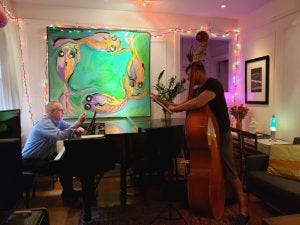Behind the Scenes: #11 The Rehearsals
A Peek Behind the Curtain: A Solopreneur Produces an Album Recording
Now we come to the most important part of any musical project: the rehearsals.
First are the rehearsals I have with piano alone. I bring the pianist the book I’ve prepared of the songs; it contains sheet music in my chosen keys with any structural changes I’ve decided in advance that I want to make and a lyric sheet that reflects the lyrics as I’ve chosen to sing them (I sometimes rearrange the order of stanzas or very slightly alter the lyrics to fit my interpretation).
The first time we run through the songs, the pianist is sight-reading unless the song is one they already know. Even if they’re familiar with the song, they might not have played it in my key or my particular arrangement. And this is the first time I’m singing the song with another person, so both of us are finding our way with the music, not terribly worried about doing it perfectly or bringing interpretation in just yet. After that initial run-through we begin to explore the music freely and make musical and interpretative choices
The first two songs I chose to prepare and record for the Elements Two project were Come Rain or Come Shine and Stormy Weather. In doing my research and listening to covers, I discovered a section in Stormy Weather, currently omitted from the song, which is heard in only one or two covers from the 1930s and 1940s; I found it to be an incredibly important addition, one which was in the composer's original score. (That’s another reason I listen to many covers from all periods and styles before I begin to interpret a song; you never know what you’ll find!) I couldn’t find sheet music anywhere that contained that section, so I pulled the score that I did have into PhotoScore and cleaned it up. Then I created that section in PhotoScore separately, note by note, and then added it to the original score in the place that I felt it worked to convey the story of the song. While time-consuming, it was well worth the effort to arrive at my own unique arrangement that expressed the lyric so beautifully and showed the song in its original richness.
Every time the pianist and I run through a portion of the song we’re developing, we each share any interpretive ideas that arise, and if we’re in agreement, we notate the changes by hand in the sheet music. After several (or many) more rehearsals, our arrangement is almost set. At that point, if there are substantial changes in the sheet music with regard to harmony or structure that we’ve agreed on, I pull the music into PhotoScore, clean up the score and make the changes, then pdf and print the sheet music for both of us again so that our scores reflect our own arrangement. That way we don’t depend on hard copies that could be destroyed or lost, losing all our hard work (voice of experience). I make certain interpretive notes in my own lyric sheet and reprint that, as well.
Once we agree on any final musical changes and I’ve edited and reprinted the music for the final time, I continue to build my version of the song interpretively with regard to my own performance.
Then it’s just a matter of running through the song a number of times to let our interpretation continue to reveal itself and to let the kinesthetic memory in our bodies develop so that the song becomes organic. It’s only then that we can really perform the song.
At that point, it’s important to me that there are no more harmonic or structural changes to the instrumental music so that I have a solid foundation on which to perform. That allows me the freedom to go with my instinct and find unexpected nuance and detail. I can’t do that if things continue to change under me unexpectedly.
Once the pianist and I have become comfortable with our final interpretation of the song, including harmony, lyrics, structure and artistic interpretation, we’re ready to add any further instrumentation we’ve agreed on that might enhance our cover.
In the case of the first two songs I chose to record, I wanted a beat, but not the sharp percussiveness of drums, and the songs required a bit of depth. I chose to use a bass to provide the rhythm and color I wanted.
I hired a well-regarded bass player, who indicated that he was fine with only one rehearsal with the pianist and me prior to joining us in the recording studio. Because I had marked the music well and could give him clear guidance, and because he was highly recommended, I felt comfortable with that. He was totally professional and played like a dream with minimal direction, both in rehearsal and in the recording session. I wish all musicians were this easy to work with!
Next up? A trip to the recording studio!
Magnify your ability to create what truly matters to you! If you’d like to succeed at making your dreams a reality, read Elena's latest book, ABRACADABRA! A Manual for Making Dreams Come True, now available on Kindle!





